Recent Articles
Popular Makes
Body Types
2020 Toyota Camry Road Test and Review
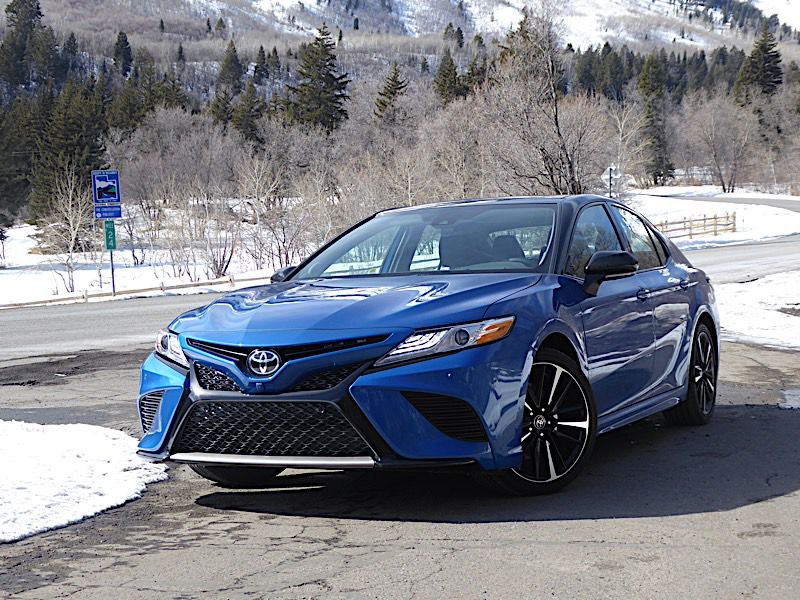
20camryawdfrontbeauty ・ Photo by Ron Sessions
The Toyota Camry was more than just the best-selling mid-size sedan in the U.S. in 2019. It was America’s top-selling vehicle that’s not a pickup truck or an SUV. Aside from a longstanding reputation for dependability and value, one of the ways the 2020 Camry appeals to so many buyers is its broad model lineup. Starting with the basic Camry L at $25,380 and topping out with the Lexus-like Camry XSE V6 at $36,085 (all including the mandatory $955 destination charge), Toyota offers more than a dozen trim levels of the four-door sedan, including three hybrid models.
New for 2020 are two additional Camry variations. For the first time, all-wheel drive is available as an option in all Camry trims with the standard four-cylinder engine except for the base L. It’s a $1,400 upcharge. The other addition to the 2020 Camry lineup is the all-new TRD model. More than just an appearance upgrade, the 2020 Camry TRD gets suspension and chassis mods that transform it into a sports sedan. Including destination, the new Camry TRD is priced at $32,125.
Capable Four-Cylinder
According to Toyota, 94 percent of all non-hybrid Camrys are currently being built with this naturally aspirated four-cylinder engine. It’s the only engine available with Camry all-wheel-drive models. With 202 horsepower and 182 lb-ft of torque on tap (boosted to 205 hp and 185 lb-ft in the XSE model) and hooked to an eight-speed step-shift automatic transmission, the 2.5-liter Dynamic Force four-cylinder offers eager response across a wide spectrum of driving situations.
This engine sports Toyota’s D-4S dual fuel-injection that utilizes both multiport and direct injectors. Additionally, it has “intelligent” variable valve timing controlled by an electric motor, laser-clad valve seats, and a host of other efficiency-enhancing measures including a variable engine oil pump and cooling system. This engine can accelerate the Camry to 60 mph in about 7.5 seconds. It’s all the engine the vast majority of Camry buyers will ever need. Depending on the model, EPA fuel economy estimates for front-drive versions are 27-29 mpg city/38-41 mpg highway/31-34 mpg combined. Camry AWD models score 25 mpg city/34 mpg highway/28-29 mpg combined. All Camrys use regular-grade fuel.
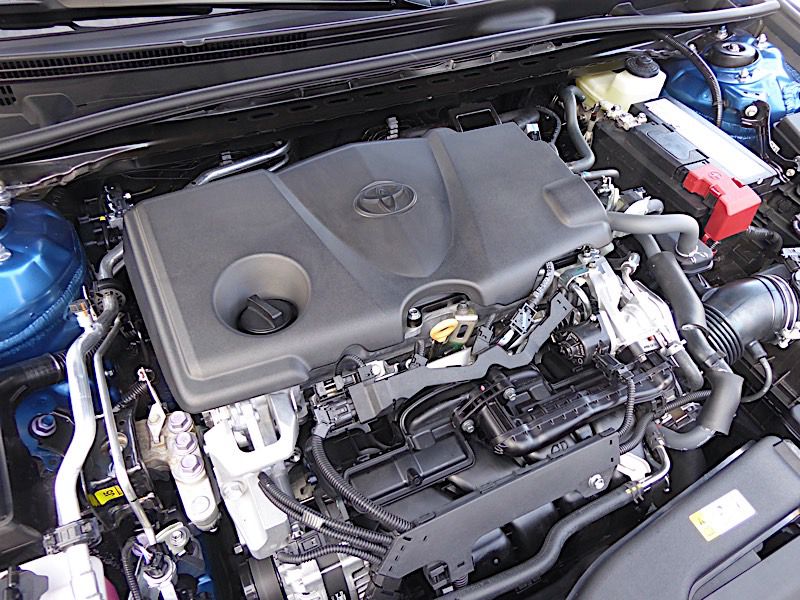
Photo by Ron Sessions
All-Wheel-Drive
This year, Toyota is bringing the all-weather, all-road driving confidence of all-wheel-drive to an expanded roster of models, including the Prius, Avalon, and Camry. In the Camry, AWD gives Toyota a model to compete with the Subaru Legacy and the newly minted AWD version of the Nissan Altima. The system now offered in the 2020 Camry is a relatively simple one, dubbed Dynamic Torque Control AWD. It’s the same system used for several years in lower trim levels of the RAV4, using a mechanical driveshaft and coupler to deliver drive torque to a rear differential and equally to each of the rear wheels. It defaults to front-wheel drive when the system detects that AWD is not needed to maintain traction and works at all speeds
The system operates seamlessly and automatically, delivering traction via all four wheels with no driver involvement required. There is, however, a 3-4 mpg drop in fuel economy compared to the equivalent front-drive Camry trim.
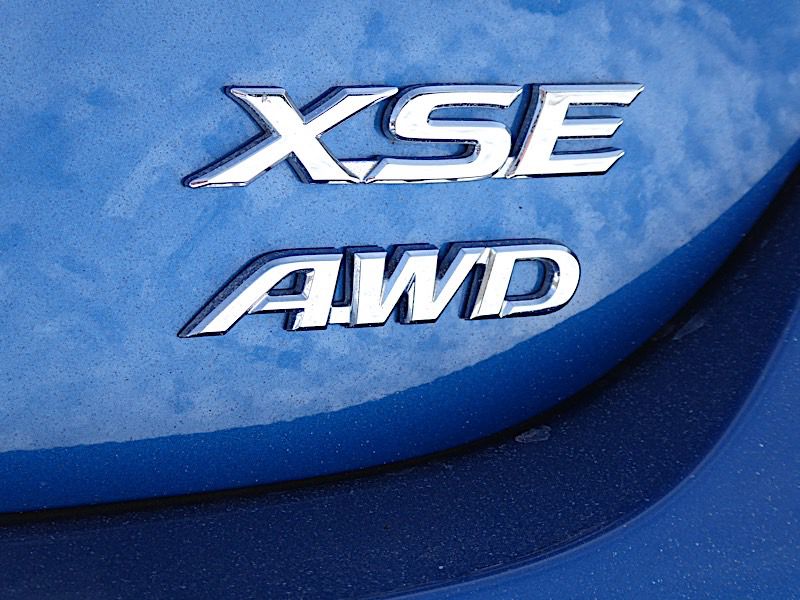
Photo by Ron Sessions
New TRD Model
It’s unlikely that the vast majority of Camry owners ever thought their sober sedan needed more rear wing. But that’s exactly what 2020 Camry TRD buyers get with a not-too-subtle pedestal-mounted rear spoiler, full body kit with ground-effect rockers, more aggressive front and rear fascias, and exclusive flat-black 19-inch alloy wheels. It’s enough of a transformation that some Subaru WRX and Civic Si drivers may steal a furtive glance.
Developed with track input, the TRD rolls with extra underbody bracing, larger front brakes, shorter and stiffer coil springs, beefier anti-roll bars, TRD-tuned gas shocks, and available summer-only tires. Ride height is reduced by 0.6 inches for a more aggressive ride stance and lower center of gravity. Special black-out exterior trim with red TRD badges, big-bore chrome-tipped cat-back dual exhaust, and red-painted brake calipers give this Camry a ready-to-rumble look. Close your eyes (not while driving) and based on the ride motions, quick turn-in, and exhaust purr, you could imagine yourself in a German sports sedan. A striking two-tone paint scheme with a gloss-black roof is also available on the TRD Camry.
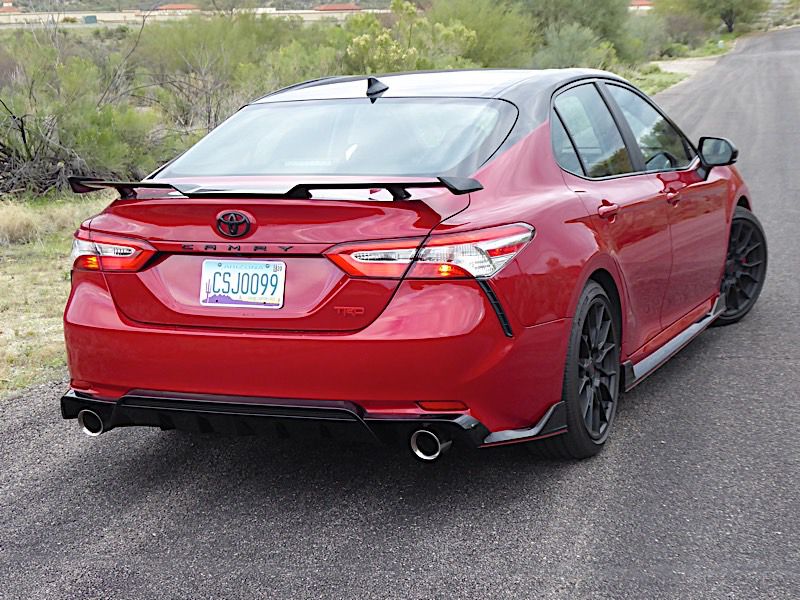
Photo by Ron Sessions
Velvety V6
All of the major Camry competitors — including the Honda Accord, Nissan Altima, Chevrolet Malibu, and Subaru Legacy — have dropped six-cylinder engines from their powertrain lineups in favor of turbocharged four-cylinders. But new Camry TRD comes standard with Toyota’s direct-injected, 301-hp 3.5-liter V6. The engine is also offered on the Camry XLE and XSE models and is shared with the Lexus ES 350 and RX 350. Using a Direct Shift eight-speed step-shift automatic, the Camry V6 can scoot to 60 mph from rest in just under 6 seconds flat, with good throttle response for overtaking on two-lane highways and merging onto high-speed freeways and a velvety exhaust note to boot.
Only 6 percent of new Camrys come equipped with this engine. EPA estimates are 22 mpg city/31-33 mpg highway/25-26 mpg combined. In the Camry, it runs on regular unleaded fuel.
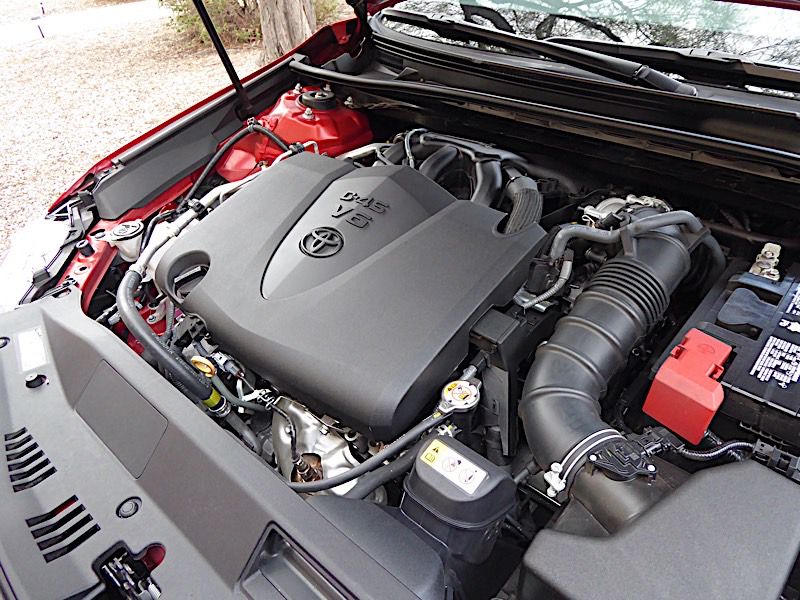
Photo by Ron Sessions
Modern Interior
With a dramatic horizontal dash design that sweeps into the doors and diagonally cut center stack and asymmetrical floor console design that could be fit for a Lexus or Audi, the Camry combines a driver-focused cockpit with upscale, soft-touch materials and trim available in Tiger Eye wood, embossed mesh, layered wood, or textured metal.
The seats are well contoured and fairly firm yet comfortable for long trips, available in cloth, SofTex microfiber, or quilted or ventilated leather. The rich interior color palette — which includes names like Macadamia, Ash, and Cockpit Red — exudes premium sedan plushness at a mainstream sedan price.
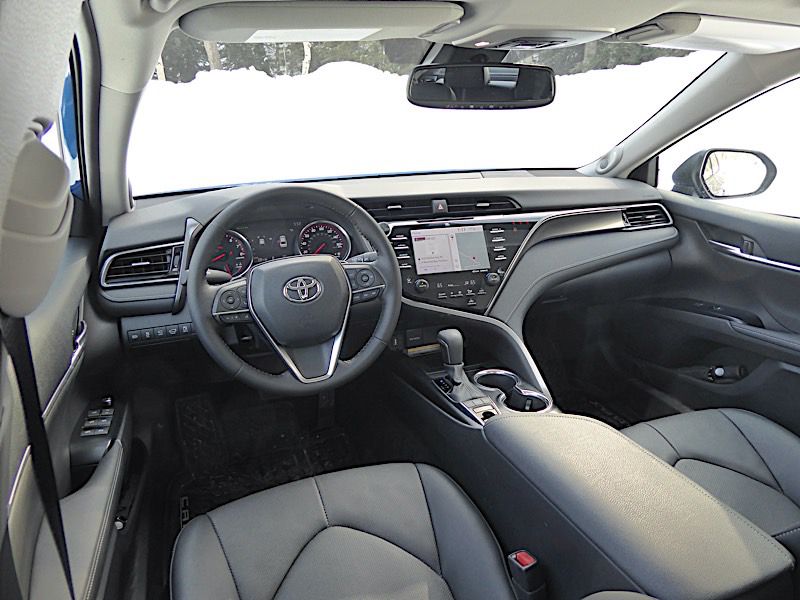
Photo by Ron Sessions
Up-to-Date Infotainment
The big news for 2020 is the addition of Android Auto cellphone mirroring to Apple CarPlay and Amazon Alexa compatibility to the Camry’s standard equipment list. It’s included in all 2020 Camry infotainment systems, including the base unit with its 7-inch touchscreen, six-speaker AM/FM, SiriusXM, hands-free phone connectivity and Bluetooth music streaming, and in-car Wi-Fi. The XLE and XSE models upgrade to an 8-inch touchscreen with HD radio and a CD player, while the XSE V6 and XLE V6 bring a nine-speaker JBL premium audio system. Navigation is an option in the XLE and XSE.
The nice thing about all Camry infotainment systems is their ease of use. The touchscreen is within easy reach of both driver and front passenger, while large analog knobs for volume and tuning and easy-to-access hard shortcut buttons flank the screen.
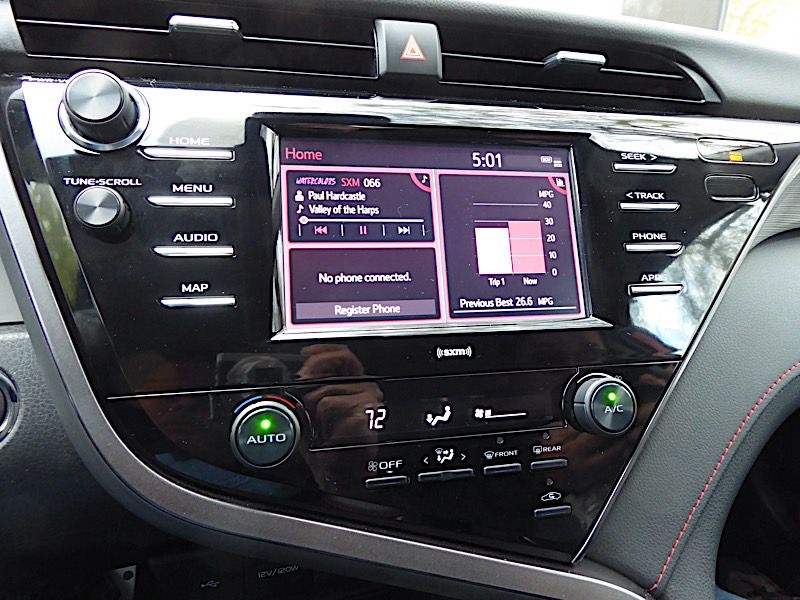
Photo by Ron Sessions
Drive Modes
All gasoline-powered Camry models offer a choice of driver-selectable drive modes. Eco delivers a more gradual throttle response under most driving situations and upshifts to higher gears earlier to keep engine revs lower, thus saving fuel. Sport brings a more responsive throttle, later transmission upshifts with easier downshifts, and higher steering effort at highway speeds. In the default Normal mode, well, the car drives like a Camry.
Interestingly, the Normal mode is also the best drive mode choice for most driving in the performance-oriented Camry TRD model. In Normal mode, the TRD had crisp throttle response and lively steering, and managed to return an observed 28 mpg around town. Eco mode tended to take the fun out of staying ahead of traffic, while Sport mode made the steering too stiff and fuel economy less thrifty.
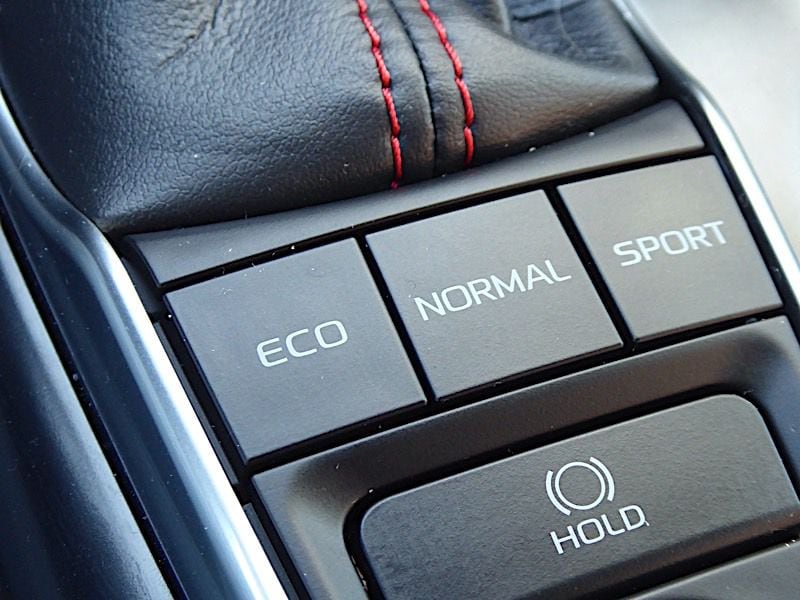
Photo by Ron Sessions
Safety Net
As with other mainstream midsize sedans, the 2020 Camry is equipped with a generous array of standard safety technology. Aside from 10 standard airbags, all Camry models come with the Toyota Safety Sense P package, including adaptive cruise control, automatic high beams, a lane-departure alert with mild steering assist, and a pre-collision system with pedestrian detection and automatic emergency braking. A backup camera with trajectory lines is also standard.
A complimentary three-year subscription to Toyota Safety Connect gives owners automatic collision notification, emergency assistance, a stolen vehicle locator, and roadside assistance. Blind-spot and rear cross-traffic monitoring are also standard on XSE and XLE models, and optional on all other trims except the TRD. An optional driver’s assistance package on the XSE and XLE includes an upgrade to an overhead bird’s-eye-view parking camera, a head-up display, and intelligent clearance sonar parking assistance with rear cross-traffic braking.
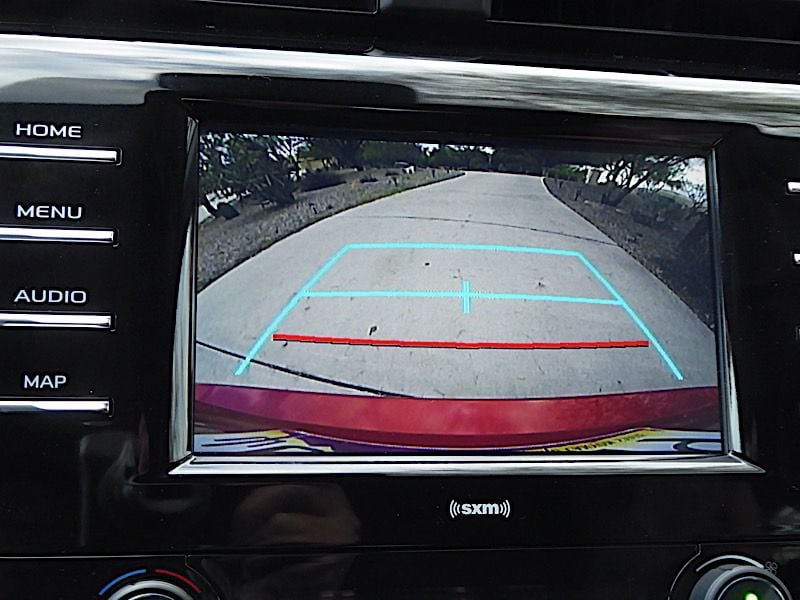
Photo by Ron Sessions
Full Lineup
Pickup trucks, crossovers, and sport-utilities may be flying off showroom floors, but the Toyota Camry four-door sedan remains immensely popular. In 2019, U.S. sales of the Camry exceeded those of all BMW models, cars, and SUVs combined.
With the addition of all-wheel drive and the all-weather, all-road confidence it delivers — especially in regions of the country that experience the snow and ice of winter — Toyota is looking to slow defections to SUVs. Toyota expects that as many as 15 percent of all 2020 Camrys purchased will be equipped with all-wheel drive. As for the surprisingly lively and fun-to-drive TRD Camry, who says all mid-size sport sedans have to be premium-priced European offerings?
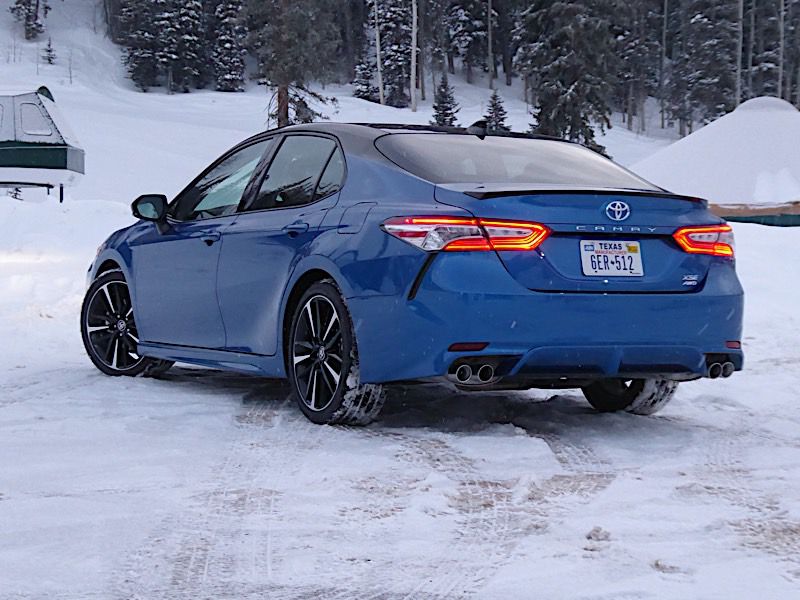
Photo by Ron Sessions